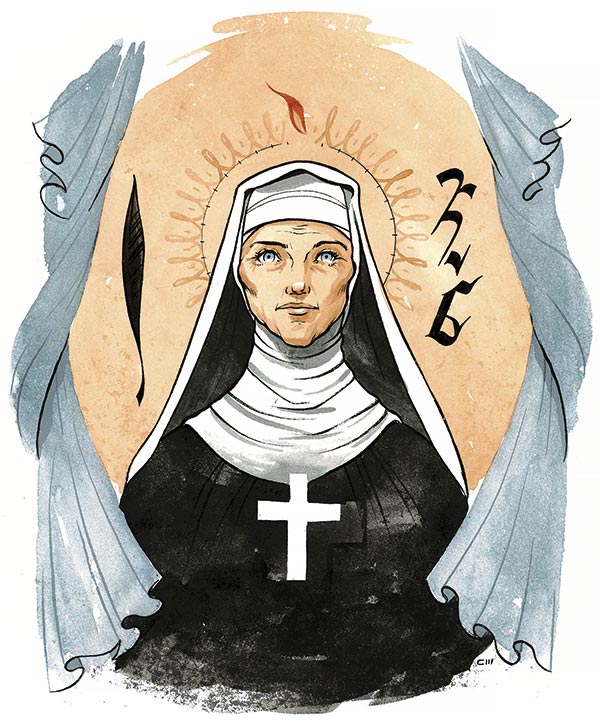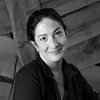Subtotal: $
Checkout-

Covering the Cover: Repair
-

Could I Do That?
-

Who Can Repair the World?
-

Rebuilding Notre-Dame Cathedral
-

Why Serve?
-

In Praise of Repair Culture
-

Just Your Handyman
-

To Mend a Farm
-

The Home You Carry with You
-

Heaven Meets Earth
-

Portraits of Survival
-

Hunger
-

Three Pillars of Education
-

The Joy of Mending Jeans
-

Zero Episcopalians
-

Making Art to Mend Culture
-

Repairing Relationships
-

Not Everything Can Be Fixed
-

Architecture for Humans
-

Yielding to God
-

Salvaging Beauty from the Ruins
-

On Motherhood and Climate Change
-

An Octopus, a Septuagenarian, and a Millennial
-

Ifs Eternally
-

Poem: “Andy Mayhew, Author of the Sonnets of Shakespeare”
-

Poem: “Daedalus”
-

Letters from Readers
-

My Liberal Arts Education in Prison
-

One Parish One Prisoner
-

What’s a Repair Café?
-

Analog Hero

The Sacred Sounds of Hildegard of Bingen
In music, art, medicine, and spiritual writings, Hildegard of Bingen sought to express “the sacred sound through which all creation resounds.”
By Susannah Black Roberts
December 5, 2023
Available languages: Deutsch
And I, a human being, neither ablaze
with the strength of strong lions nor learned in their exhalations, remaining in the fragility
of the weaker rib, but filled with mystical inspiration, saw …
In the winter of 1148, in Trier in Germany, Pope Eugenius III found himself with a manuscript, a half-finished work of a curious nature. The pope’s former teacher Bernard of Clairvaux had brought it to him; Bernard had received it more than a year earlier, with a cover letter that addressed him in terms at once anxious and confident.
“Venerable Father Bernard,” his interlocutor had written, “you are held in wonderfully high honor by the power of God…. Father, I ask you, by the living God, to attend to my questions.”
The writer was a nun, the abbess of a small convent in the Rhineland. Born in 1098 to a noble family, the tenth child, she was given as a tithe to the church, and dedicated as an oblate. At some point before she was eighteen, she took the vows of a nun.
We know little of the next twenty years of her life, but in 1136, the nuns of her convent chose her as abbess. It was in 1141 that, with the encouragement of a monk called Volmar, a friend, she started to write.
She had a lot to get down.
She had had visions.
It was the content of these visions, and her reflections on them, that Pope Eugenius III found in the manuscript that his old teacher presented to him. Impressed with their strange, vivid authority and convinced of their orthodoxy – though it was an orthodoxy expressed at times in highly original terms – the pope confirmed Hildegard’s visions as legitimate and gave permission for the work to be published.
Hildegard’s life changed drastically after that. She spent the next thirty years as a public figure: an author, political advisor, and spiritual director. She undertook many speaking and missionary tours throughout Europe and founded two new convents. She composed music and made visionary works of art, reproductions of what she saw: pieces that look for all the world like mandalas containing detailed allegorical figures.

Cory Mendenhall, Hildegard of Bingen, watercolor and ink on paper, 2023. Used by permission.
As well as her visionary and theological works, she wrote scientific and medical treatises, songs, and an opera, which her nuns performed. She corresponded with many of the leading figures of her day: four popes, many churchmen, and, on at least one occasion, the Emperor Frederick Barbarossa, when he had yet again interfered in church politics. “I see you like a little boy or some madman living before the Living Eyes,” she wrote, warning him to shape up and stop electing antipopes.
And, apparently, she continued to have the visions that fueled this wealth of insight and creativity. She had first seen what she called “the Shadow of the Living Light” at age three. “I have seen great wonders since I was a child,” she told Bernard, and she really didn’t know what to make of them. “Most gentle Father, you are secure; in your goodness please answer me, your unworthy servant, for since I was a child I have never felt secure, not for a single hour!”
She’s been posthumously diagnosed, as other visionaries have, with hystero-epilepsy, with migraine (though she mentioned no head pain to go with her visions), and so on. But such diagnoses do virtually nothing to reach into the experience and mind of this remarkable woman.
What we know is what she tells Bernard, and us: she has seen visions and received teaching about them; she believes that the teaching regards spiritual readings of the scriptures, but she’s worried that she may be going wrong. “I only know how to read for the simple meaning, not for any textual analysis…. I am taught inwardly, in my soul. Therefore I speak as one in doubt.” She’s something like Saint Paul going to Saint Peter to make sure that his visionary experience of Christ lines up with the concrete historical teachings of Christ. She wants to lay her understanding at the feet of the apostles, to not go haring off after esoterica.
“The soul humidifies the body so it does not dry out, just like the rain which soaks into the earth.”
Hildegard of Bingen
Her entreaty itself gives a flavor of the way reality presented itself to her – or rather the way God presented himself to her, and presented the cosmos as his creation. “I entreat you: by the brightness of the Father, by his wonderful Word, by the sweet humor of compunction, by the Spirit of Truth, by the sacred sound through which all creation resounds, by the Word from which all the world was created, by the height of the Father who through the sweet power of green vigor sent the Word to the Virgin’s womb where it took on flesh like honey in the honeycomb!”
She was captivated by this sense of the living reality of God’s life imbuing all of the cosmos – and the microcosm of the human body – with the “green vigor” of the Spirit. And the strength and insight that these visions gave her enabled her to help build the international body of the church, knitting it together with letters offering political, spiritual, and personal advice, and with poetry and painting and medicine and music and motherly affection.
A remarkable event marked the last year of Hildegard’s life; it demonstrates her steadfastness in the face of injustice. A nobleman who had been excommunicated died after making his confession to a priest and receiving the sacraments. Hildegard had him buried in the convent cemetery. The prelates of the diocese of Mainz, claiming falsely that there had been some impropriety in the young man’s reconciliation, demanded that his body be exhumed. Hildegard refused. The clergy placed her convent under an interdict, forbidding the nuns to receive the sacraments or to sing the liturgy. Hildegard, as usual, wrote letters, advocating for her nuns and herself, and several months before her death the injunction was lifted.
Already a subscriber? Sign in
Try 3 months of unlimited access. Start your FREE TRIAL today. Cancel anytime.










































Philip Bess
Wonderful short essay Susannah, and as byproduct an excellent argument for an excellent Church Teaching Office ( for we papists its current excellence now under question, not unreasonably and, ahem, not for the first time). And Hildegard seems to be *everywhere* these days. Perhaps she always has been, but I didn't really notice her until The Lockdown, when I engaged Tess Gunty's award-winning first novel 'The Rabbit Hutch', about an orphan generation in a town quite like South Bend, in which Hildegard featured prominently. But THEN, 'Bardcore' emerged among the Zoomers, the very loveliest works coming from the redoubtable Canadian composing under the name Hildegard von Blingin' (including in her oeuvre a cover of an original Hildegard composition). I'll be shocked Susannah if this is news to you. I suspect however that any of your readers who now know of the original Hildegard but know not the work of Ms. von Blingin', if they but google they will enjoy, and perhaps even approve.